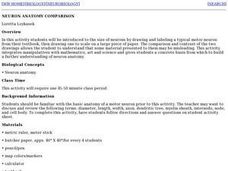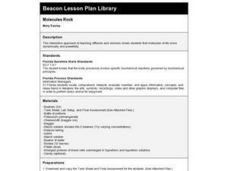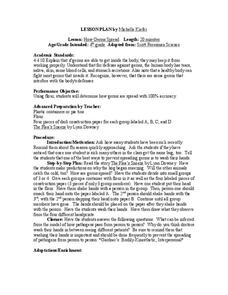Curated OER
Gregory Carter
Young scholars explore how the immune system, fights a war with a pathogenic organism: one of the many bacteria, viruses, and protozoans that can infect our bodies and cause disease.
Curated OER
Science: About Your Body
First graders examine body systems and demonstrate their competency in a quiz game show. Lessons cover the brain, heart, lungs, digestive system, muscles, and bones. Students , in teams, answer teacher-created questions in the game.
Curated OER
Sequencing the Cystic Fibrosis Gene: A Simulation
Ninth graders determine nucleotide sequences. They identify those base sequences that are normal, those that are normal variants and those that cause cystic fibrosis. Students use DNA nucleotide sequences to determine amino acid...
Curated OER
HOW SMALL AM I? THE SCIENCE OF NANOTECHNOLOGY
Students study nanotechnology and investigate the dimensions of a nanoscale. In this nanometer study lesson students will see how truly small a nanometer is by measuring things such as a piece of hair.
Curated OER
The Fight for Life
Students explore the far-reaching impact of AIDS. In this World AIDS Day lesson, students research and compare AIDS statistics as well as advancements in treating AIDS. Students create AIDS awareness posters.
Curated OER
Staying Healthy
In this nutrition worksheets, learners solve 6 word scrambles, 4 riddles, and complete 2 word puzzles about diet and nutrition.
Curated OER
DNA Fingerprinting Simulation
In this DNA fingerprinting simulation worksheet, students perform an activity that represents using a gel electrophoresis. Students decide who commits a crime in a forensics style lab.
Curated OER
Karyotype Alternatives
Students study karyotyping, which is a process in which chromosomes are cut out from an enlarged picture and arranged in decreasing order of size. They use a template to arrange and glue chromosomes to data sheet, indicate sample code,...
Curated OER
Defense Against Infectious Diseases
In this infectious disease defense activity, high schoolers will review the immune system including acquired, antibody, and cellular immunity. Students will then compare passive and active immunity to infectious diseases. This activity...
Curated OER
Ranking Salinity
Students explain the uses of titration in chemistry and in industry. In this chemistry lesson, students determine the concentration of an unknown solution using titration. They calculate the percent of salt in saline solutions.
Curated OER
Neuron Anatomy Comparison
Pupils create a scale model of a motor neuron that is two hundred times larger than the actual neuron. They identify the structures of a neuron and observe neurons under the microscope then use a worksheet to convert actual sizes into...
Curated OER
Health: STDs and Their Symptoms
Students explore the myths and realities associated with sexually transmitted diseases. In a Powerpoint presentation, they discover the characteristics of various diseases, treatments, and complications. In their journals, students...
Curated OER
Human Heredity Traits
Completing an idea map based on various inheritance factors and mistakes, 9th graders review their knowledge of genetic disorders. While the activity is based on chapter 15 of an unnamed textbook, the questions at the bottom of the page...
Curated OER
COMPARISON OF FOUR-, SIX-, AND EIGHT-bp CUTS IN CALF THYMUS DNA
Students use this laboratory exercise, restriction enzymes to recognize a four-, six-, and eight-nucleotide sequence. Assuming that the four component nucleotides (A, C, T, G) are distributed randomly within a DNA molecule, then any...
Curated OER
Bone and Joint
In this health worksheet, learners find the words that are found relating to bones and joints. The answers are found at the bottom of the page.
Curated OER
Gases and Chemical Reactions
In this chemical reactions worksheet, learners calculate the volume or pressure for different gases. Students determine the effect of different stimuli on the rate of a chemical reaction. This worksheet has 1 short answer, 10 fill in the...
Curated OER
Molecules Rock
Fourth graders engage in this interactive instructional activity which illustrates diffusion and osmosis and shows them that molecules of life move dynamically and powerfully. They must analyze their lab orally and in writing.
Curated OER
How Germs Spread
Fourth graders investigate how germs spread in this lesson. They listen to "The Flea's Sneeze" by Lynn Downey and make predictions on why the hog began sneezing. They then conduct an experiment using flour and paper cups demonstrating...
Curated OER
Mr. Bones
In this health activity, students find the words that are associated with the bones of the human body and the answers are found at the bottom of the page.
Curated OER
Moving the Body
In this musculoskeletal system learning exercise, students review the function of bones and muscles in this body system. Students also review the different types of muscles: smooth, skeletal, and cardiac. This learning exercise has 10...
Curated OER
Air Pollution
In this pollution activity, students read about how air pollution is created and the harmful products that come out of a car exhaust. Then students complete 9 short answer questions.
Curated OER
Water 1: Water and Ice
Students explore the water cycle. In this water cycle lesson, students complete a hands-on activity that replicates the water cycle. Students record their observations.
Curated OER
Why Does My Body Smell?
Fourth graders investigate how germs spread among people. In this health lesson plan, 4th graders discover the causes of infection and proper hygiene methods.
Curated OER
Respiration
In this respiration worksheet, students label the respiration diagram, and fill in the blanks for a paragraph on respiration using a word bank. Students complete 12 words total.
Other popular searches
- Red & White Blood Cells
- White Blood Cells
- Red Blood Cells
- Making Blood Cells
- Dancing Blood Cells
- Prue Assessment Blood Cells
- Pre Assessment Blood Cells
- Pr Assessment Blood Cells
- Pre Assessment Blood Cells
- Compair Blood Cells
- Blood Cells Microscope Lab
- Red Blood Cells Slide

























